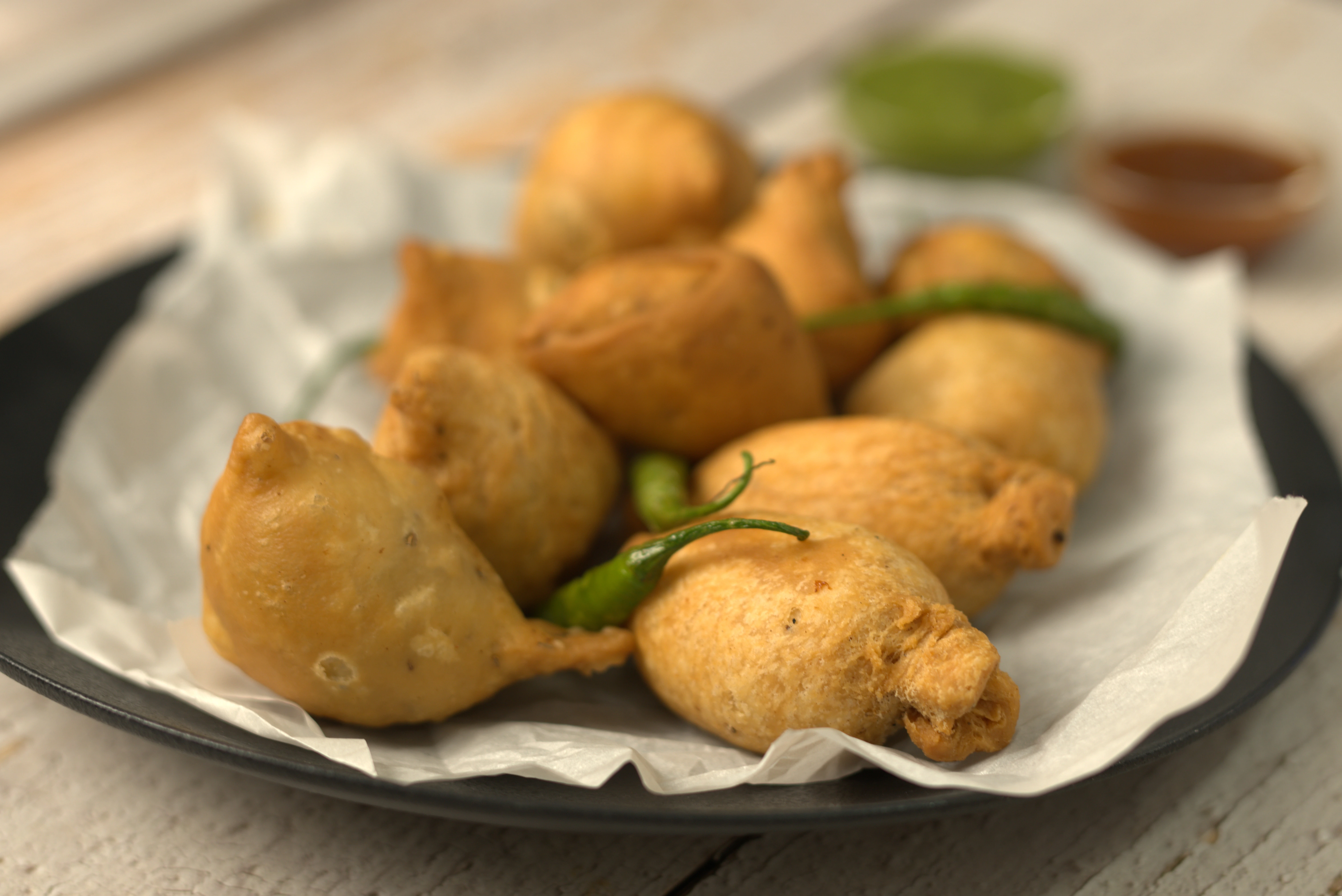
Samosa Recipe

20 mins

2-3 people

15 mins
Introduction:
Hey there, fellow food enthusiasts! Allow me to take you on a delectable journey through the vibrant streets of India, where every corner boasts the tantalizing aroma of freshly fried samosas. Picture this: the sun setting over bustling markets, vendors skillfully crafting these crispy, golden parcels of goodness, and the anticipation building with every bite. Ah, the memories flood back as I reminisce about my first encounter with this iconic snack.
I vividly recall the bustling streets of Mumbai, where I stumbled upon a tiny stall nestled amidst the chaos. Curiosity piqued, I approached, drawn in by the heavenly scent wafting through the air. One bite was all it took to transport me to culinary nirvana - the perfect blend of spiced potatoes, fragrant herbs, and crispy pastry shell. From that moment on, I was hooked!
Recipe of Samosa
Ingredients:
For Samosa Stuffing:
- 3 tbsp Oil
- 1 tsp Cumin seeds
- 2 Green Chilies, chopped
- 2 Onions, chopped
- 1 1/2 tsp Ginger-Garlic paste
- 1 tsp Salt
- 1 tsp Red Chili Powder
- 1 tsp Turmeric Powder
- 1 tsp Coriander Powder
- 1 tsp Roasted Cumin Powder
- 1 tsp Garam Masala powder
- 1 Tomato, chopped
- 1/2 tbsp Water
- 1 cup Tomato Puree
- 1 cup Soyabean Kheema (soaked and hydrated)
- 1 tsp Kasuri Methi (Dried Fenugreek Leaves)
- 2 tsp Coriander leaves, chopped
- 4 cubes of Cheese, grated
For Samosa Dough:
- 1 cup Maida (All-purpose flour)
- 1 tsp Ajwain (Carom seeds)
- 2 tsp Salt
- 1 tbsp Oil
- Water (as needed)
For Frying:
- 2-3 cups Oil
Method:
For Stuffing:
-
Heat oil in a pan, add cumin seeds, and allow them to crackle. Add chopped green chilies and onions. Cook until onions turn translucent.
-
Add ginger-garlic paste, salt, red chili powder, turmeric powder, coriander powder, roasted cumin powder, and garam masala. Cook for a few minutes until the raw smell disappears.
-
Add chopped tomato and tomato puree. Mix well. Add hydrated soyabean kheema. Cook on low flame for 10 minutes.
-
Add kasuri methi and chopped coriander leaves. Mix well. Transfer the mixture to a clean plate and allow it to cool. Add grated cheese to the cooled mixture.
For Dough:
-
In a mixing bowl, combine maida, ajwain, and salt. Mix well.
-
Add oil and rub it into the flour mixture.
-
Gradually add water and knead the dough until it's smooth and pliable. Cover the dough and let it rest for a while.
For Making Samosas:
-
Divide the dough into small balls.
-
For traditional samosas, roll out each dough ball into a circle, cut it into halves, and form cones by sealing the edges with water. Fill the cone with the prepared stuffing and seal the open edge.
-
For patti samosas, roll out the dough into a rectangular shape. Cut it into strips. Place the stuffing in the center of each strip and fold it into a triangular shape.
-
For samosa rolls, roll out the dough into a square. Cut it into smaller squares. Place the stuffing in the center of each square and roll it into a cylinder shape.
-
Heat oil for frying in a deep pan. Once the oil is hot, carefully drop the prepared samosas into the oil and fry them until golden brown and crisp.
-
Remove the fried samosas from the oil and drain excess oil on a paper towel.
-
Serve the hot and crispy samosas with chutney or sauce of your choice.
Enjoy the delicious homemade samosas as a snack or appetizer!
About the Recipe:
Now, let's delve into the heart of this beloved recipe. Samosas, with their origins steeped in rich Indian culinary tradition, have become a global sensation. These triangular delights are typically filled with a savory mixture of spiced potatoes, peas, and sometimes even minced meat, encased in a crispy, flaky pastry shell. Whether enjoyed as a quick snack on the go or served as a mouthwatering appetizer at gatherings, samosas never fail to delight the taste buds.
Cooking Tips:
- Ensure the pastry dough is rolled out thinly to achieve that perfect balance of crispiness and flakiness.
- Fry the samosas in hot oil until they turn golden brown and crispy on all sides.
- For a healthier alternative, you can bake the samosas instead of frying them.
- Experiment with different fillings such as paneer, lentils, or minced chicken for a unique twist on this classic recipe.
- Serve the samosas hot with a side of tangy tamarind chutney or spicy green chutney for an extra burst of flavor.
Pairing Guide:
Samosas pair beautifully with a variety of beverages and accompaniments. Here are some delightful pairings to elevate your samosa experience:
- Pair with a piping hot cup of masala chai for the perfect afternoon snack.
- Serve alongside a refreshing mint yogurt dip for a cool contrast to the spicy filling.
- For a more indulgent treat, enjoy samosas with a side of creamy mango lassi or refreshing nimbu pani (lemonade).
- Pair with a crisp, cold beer or a glass of fruity white wine for a modern twist on this traditional snack.
Frequently Asked Questions about Samosas:
-
What is the origin of samosas?
- Samosas trace their origins back to the Middle East and Central Asia before making their way to the Indian subcontinent, where they evolved into the beloved snack we know today.
-
Can I make samosas ahead of time and reheat them?
- Yes, you can make samosas ahead of time and reheat them in a preheated oven until they are heated through and crispy again.
-
What is the best way to store leftover samosas?
- Store leftover samosas in an airtight container in the refrigerator for up to 3-4 days. Reheat them in the oven or microwave before serving.
-
Can I freeze samosas for later use?
- Yes, you can freeze uncooked samosas for later use. Place them on a baking sheet and freeze until firm, then transfer to a freezer bag or container. Fry or bake them directly from frozen, adding a few extra minutes to the cooking time.
-
How do I prevent samosas from becoming soggy?
- To prevent samosas from becoming soggy, ensure that the filling is completely cooled before assembling and frying. Additionally, make sure the oil is hot enough before frying to achieve a crispy exterior.
-
What are some creative samosa filling ideas?
- Get creative with samosa fillings by experimenting with ingredients like spinach and feta, caramelized onions and mushrooms, or even barbecue chicken and cheese.
-
Can I make samosas gluten-free?
- Yes, you can make gluten-free samosas by using a gluten-free flour blend for the pastry dough. Ensure that all other ingredients used are also gluten-free.
-
What are some vegan alternatives to traditional samosa fillings?
- Vegan alternatives to traditional samosa fillings include combinations like spiced tofu and vegetables, chickpeas and sweet potatoes, or even a mixture of lentils and spinach.
-
How do I achieve the perfect crispy texture when frying samosas?
- Achieve the perfect crispy texture by frying samosas in hot oil at the right temperature (around 350°F/180°C) and ensuring that they are evenly golden brown on all sides.
-
Can I serve samosas as a main dish?
- While samosas are traditionally served as a snack or appetizer, you can certainly enjoy them as a main dish alongside a fresh salad or rice pilaf for a satisfying meal.
With these handy tips and tantalizing pairings, you're well-equipped to embark on your samosa-making adventure. So, roll up your sleeves, gather your ingredients, and let the culinary magic unfold!
